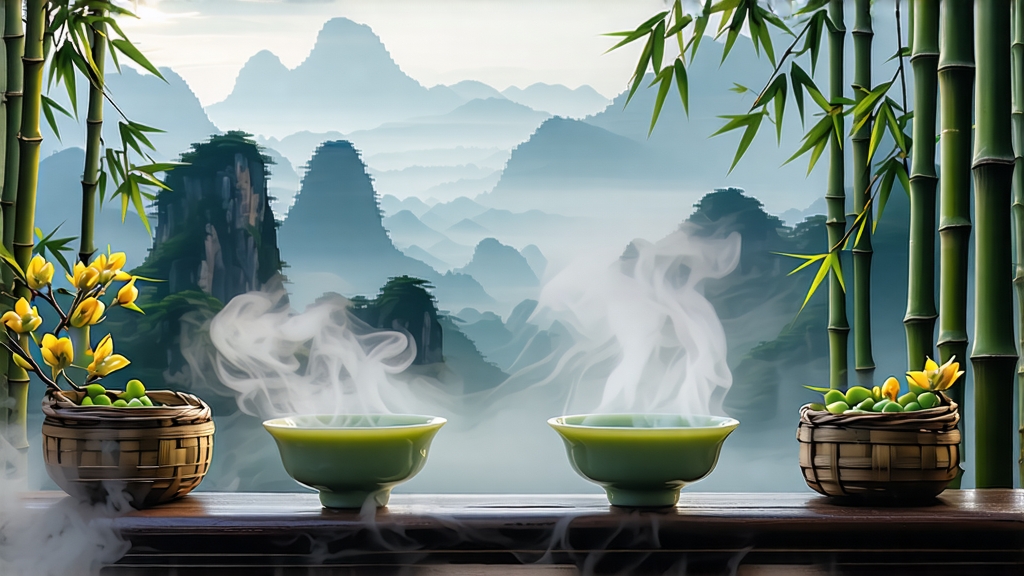
Hidden between the granite spires of the Dabie Mountains in western Anhui Province, Huoshan Huangya has quietly preserved the most delicate ritual of “smother-yellowing” for fourteen centuries. While green tea commands global fame and pu-erh dominates investment portfolios, this downy, sulfur-yellow bud tea once rode on horseback to Chang’an, sealed with wax and silk, to satisfy the Tang emperor’s insistence on “a liquor the colour of morning sun on imperial robes.” Today only 280 acres of the original Songzi cultivar remain, clinging to misty ledges above the Huoshan reservoir, making each spring harvest rarer than the last.
History: from tribute to near extinction
The first written record appears in 780 CE when Lu Yu, the “Sage of Tea,” noted that Huoshan monks presented “yellow sprouts” to Emperor Dezong. During the Ming, the tea was pressed into dragon-phoenix cakes, then loose-budded in the Qing when the Kangxi Emperor declared it one of four “end-of-year tributes” alongside Dahongpao and Longjing. The 20th century brought war, land reform and the Cultural Revolution; gardens were uprooted for sweet potato. In 1972 a retired soldier named Li Fuzhong found three ancient bushes inside a ruined temple, collected 42 seeds, and restarted the lineage that now feeds the entire appellation.
Micro-terroir: why the mountain makes it yellow
Huoshan county straddles the 31st parallel, the same band that nurtures matcha in Uji and first-flush Darjeeling. Yet its magic lies in diurnal shock: daytime valley heat rises, meets the reservoir’s cool breath, and rolls back as fog at dusk. The tea bushes, mostly the small-leaf Songzi and the heart-shaped Jinfeng clone, respond by thickening their epidermis and storing extra lutein, the carotenoid that later turns the leaf a translucent egg-yolk yellow during smothering. Soil is granite-weathered quartz with 4.3 % organic matter, ultra-draining and low in iron, preventing the astringent catechins that scar green teas.
Plucking etiquette: one bud, one leaf, before Qingming
The picking window opens on the 20th of March and closes on the 5th of April, when night temperatures still dip to 8 °C. Only the standard “one bud, one leaf still half-folded” is taken, ideally before 10 a.m. while dew lingers. Experienced pluckers use a twist-pinch motion to keep the hydathode pore intact; a broken stem oxidises within minutes and will refuse to “yellow” evenly. Daily yield per worker is a mere 600 g fresh leaf, translating into 120 g finished tea—one reason true Huoshan Huangya retails above US $1,200 per kilogram.
Craft: the lost art of menhuang (闷黄)
Western tea literature often mistranslates menhuang as “fermentation,” yet it is closer to a controlled asphyxiation. The process has five milestones:
- Sha-qing (kill-green) over bamboo charcoal at 160 °C for 90 seconds: the leaf temperature must reach 85 °C to deactivate polyphenol oxidase, but the shorter dwell time preserves the yellow pigment.
- Re-moistening: the hot leaf is piled 8 cm deep inside linen sacks and sprayed with 3 % ambient-temperature reservoir water; moisture climbs back to 28 %.
- First smother: sacks rest in a pine-wood box for 24 h at 32 °C and 78 % RH; lutein isomerises, chlorophyll rings open, and the grassy hexenal volatiles drop by 60 %.
- Rolling under light pressure (4 N/cm²) for 12 min to rupture 35 % of cell walls—less than green tea, ensuring the liquor remains gentle.
- Second smother: the twisted leaf is re-steamed for 20 s, then buried under a 4 cm rice-husk blanket for another 18 h. This is the critical “yellowing core”; technicians listen for a faint apricot aroma before unearthing.
Finally the leaf is dried in three descending cycles: 90 °C, 70 °C, 50 °C, each followed by a 30 min rest to equalise moisture. Total